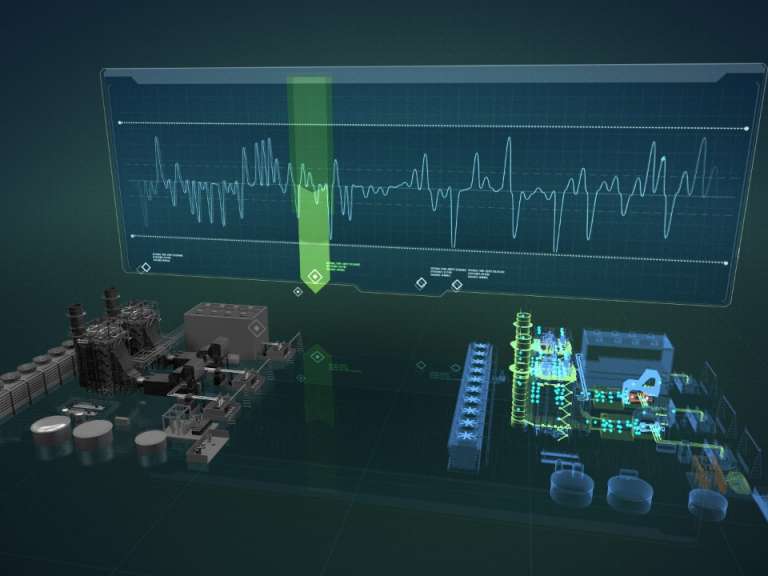Time to Befriend the Digital Twins
Alex ForbesDigital twins—virtual copies of industrial assets—can ensure that maintenance is based on need rather than on the calendar, reduce fuel use, and assist with energy trading decisions. Here's how.

Imagine a power plant in which a gas turbine could detect that something was not quite right, analyze the options available to solve or mitigate the problem, and make specific recommendations to its human operator. Now enlarge that idea to cover an entire combined-cycle power station, with its gas turbines, steam turbines, boilers, generators, and control systems all able to tell their human operators how best to avoid unplanned downtime, enhance plant efficiency, and increase business profitability. As in so many aspects of modern life, what sounds like science fiction is quickly becoming science fact. Meet the digital twins.
The technology was originally developed by NASA as a way to manage assets that were too far away for conventional methods that require proximity. Today—in line with the trend toward the Internet of Things (IoT)—digital twin technology is being adopted by a growing range of industries, as the technologies that make it possible become more widespread and cost effective, and as awareness of its benefits builds. According to some estimates, within five years the total number of digital twins across all industries could be in the billions.
Digital twin is a new term for an old concept. It follows the general idea of methods like a finite element model or a representation of a physical process using discrete event simulation. Today, the world is embracing digital technologies, and the digital twin terminology simply describes new approaches to simulating the real world in ways that are becoming increasingly accessible to decision-makers in the power industry.
A digital twin is a functioning virtual copy of a power plant, or other industrial asset, that exists in the digital realm. It can simulate numerous scenarios in real time, ensuring that maintenance is based on need rather than on the calendar. This reduces fuel use and assists with energy trading decisions by incorporating business data into digital twin analytics.
Implementation of the latest digital twin technology is only now becoming a reality, because it brings together the industrial internet, sensors and controls, edge computing, the cloud, powerful analytics, advanced software, and a growing base of real-life data accumulated over time, from individual assets and entire fleets.
The digital twin captures the operating history of its physical twin, records key performance indicators (KPIs) to monitor present performance, and offers insights for the future to drive and predict business outcomes. The emphasis is on alerting the operator of when an asset such as a steam turbine is approaching a problem and the costs and benefits of the various options available.
Here's an example of how it can work from a recent conference demonstration by Colin J. Parris, Ph.D. A digital twin of a steam turbine in southern California alerts its operator that changes in its usage pattern have led to a sharp increase in rotor wear. When questioned, it reports on how its operating profile has changed. Start–stop cycles are up 27.5 percent. The rotor damage rate has increased by 4.0 times. If this continues, loss of remaining life will be 69.9 percent.
What are the options, then, for mitigating rotor damage? Based on weather forecasts, historical data, fuel cost, and electricity pricing, the digital twin puts forward two options to enhance operations. The first is to manually slow down the start-up ramp rate to reduce rotor wear; the second is to download an optimization app that will apply stress controls to reduce wear and fuel consumption. Option two is based on 15 years of historical data, fleet learning from 125 similar steam turbines, and 58,965 simulation runs. Confidence level is 95 percent.
The app can precisely monitor the load and the ramp rates, aligning them with the steam temperature so that the thermal stresses on the rotor are limited as much as possible.
The operator asks for a financial perspective. The digital twin reports that stress will reduce by 25 percent, bringing the damage rate back to the normal range. Start-up fuel cost will go down by 40 percent and start-up time will be cut by 50 percent. Additionally, a potential $12 million unplanned outage cost will be avoided. The operator selects option two, and the digital twin implements it.
Digital twin technology can be implemented on several levels. A parts twin, like the example above, can deliver early warnings about potential problems and the nature of possible failures—essentially an advanced example of predictive maintenance. A product twin can monitor the remaining life of an asset, such as a steam turbine, and protect against unnecessary maintenance costs. A process twin can adjust the scheduling of field engineers to increase utilization. A system twin can enhance operations and weigh KPIs, such as balancing revenue against remaining life and maintenance costs.
Ultimately, digital twins can be used to predict not just potential failures, but also potential business opportunities. We are on the cusp of an era when the minds of humans will regularly communicate with the minds of machines. Machines equipped with AI and machine learning will become more like employees—taking the initiative when appropriate. It's time to get to know the digital twins.
Eradicating hazards completely is impossible, but new power plant safety innovations can mitigate risk.
Improving flexibility and efficiency at low loads can enhance steam plant profits, along with lowering maintenance costs.
Power plant managers should keep watch for energy industry trends in 2017: rise of distributed generation, fuel mix changes, digital technology, and more.